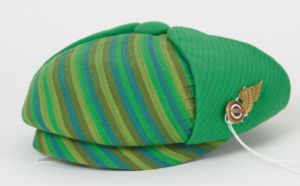April 17, 2017
In the early years of airline flights, flight costs were prohibitively expensive for many Americans. In order to cater to wealthy customers, airlines wanted to create an environment where people felt lavished, complete with beautiful female attendants. It was after World War II, when Northwest Airlines, based out of Minneapolis, began flights to Asia over the Pacific that “a new era at the airline was ushered in,” and rigid expectations were placed on their flight attendants. Anne Billingsley Kerr, who worked for the airline from 1956 to 1960, when she was forced to retire because of her marriage, remembered:
“Back in the Dark Ages, the requirements were you had to be 21, not over 31, you had to be between 5’4” and 5’8”, you had to have weight in proportion to height, we were weighed periodically to be sure. We had to have 20/20 vision and there had to be no obvious flaws. I even hate to say it, but that was the way that it was.”
Cheryl Ullyot, who donated her stewardess uniforms to Hennepin History Museum, was 20 years old when Northwest Airlines, then called “Northwest Orient Airlines,” hired her in 1969. Like Kerr, Ullyot reminisced about the many regulations for stewardesses’ appearances, writing, “A chip in my nail polish or a run in my nylons meant a dock in pay.” They were expected to wear skirts and high heels at all times for a ladylike appearance.

There were good and bad aspects of being a stewardess. It was a chance to see the world and to meet exciting passengers aboard. “It was a glamorous job,” said Ullyot, “I loved going to work because I never knew whom I might meet.” Fay Kulenkamp, who worked with Northwest from 1968 to 2004, was able to help her parents travel despite the expensive prices of flights. Kulenkamp said, “I thought it would be really nice for my parents to use my passes and take some trips that they ordinarily would not be able to afford.” My aunt, Pam Gunderson, formerly Fredrickson, remembers meeting comedian Bob Hope and actor Georgie Jessel during her time as a flight attendant. But memorable passengers were not always celebrities. “I started at NWA in 1969 during the war in Vietnam and had many soldiers on flights,” Pam wrote, saying:
“One young man had lost both legs in the war and was going home to see his fiancé. I asked him if he wanted a wheelchair to deplane, but he said he wanted his fiancé to see the whole truth right away. I had to duck into the cockpit because I couldn’t watch him struggle. I have often wondered what became of him and the others who flew home with us.”
In the end, the benefits of being a flight attendant were not enough to overshadow the discrimination women faced at Northwest and other airlines. My aunt Pam had left Northwest Airlines by the time of the Laffey v. Northwest lawsuit in 1973. According to Kathleen Barry, in her book Femininity in Flight: A History of Flight Attendants, the lawsuit was “the broadest yet against airline bias.” The case detailed how women were kept from being promoted, received unequal benefits, and of course, the many restrictions placed on acceptable age and appearance. Even the title “stewardess,” it seems, was one that suggested women’s jobs were somehow different than male “flight service attendants.”
Northwest Airlines survived the Laffey case, and eventually merged with Delta in 2010. Today, while women still struggle to receive equal pay at jobs all across the country, we still regard much of the treatment of early female flight attendants as unfair and extreme. While being a stewardess was considered to be a glamorous job in the eyes of some, glamor did not outweigh the changes that needed to be made.
Written by HHM intern Caitlin Crowley. Caitlin is a current Augsburg student where she is majoring in history with a Medieval History minor. She comes to HHM through the Minnesota Historical Society’s ACTC extern program.

Sources
Cheryl Ullyot, “Random thoughts,” Hennepin History, Winter 2006, 3.
Kathleen Barry, Femininity in Flight: A History of Flight Attendants, Duke University Press, 2007, 170.
“Lost Twin Cities,” TPT Documentaries video, 3 August 2014, http://video.tpt.org/video/2365436746/.
